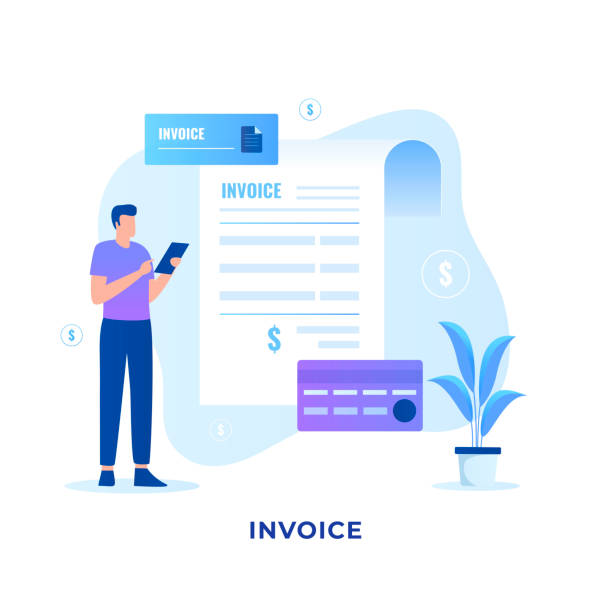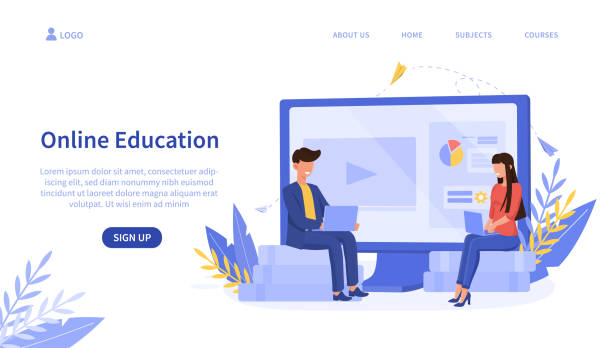Introduction and the Importance of User-Friendly Website Design in the Digital Age

In today’s fast-paced world, an online presence is vital for every business, and a website plays the role of the pulsating heart of this presence.
But merely having a website is not enough; what matters is user-friendly website design.
#UserFriendlyWebDesign not only provides a pleasant experience for visitors but also directly impacts your conversion rate, customer loyalty, and ultimately, your business’s success.
A user-friendly site is one where users can easily navigate, find the information they need, and perform their desired actions without any difficulty.
This concept goes beyond visual aesthetics and includes factors such as loading speed, compatibility with various devices, and accessibility for all users.
Neglecting these principles can lead to user abandonment and the loss of countless opportunities.
The importance of user-friendly website design is such that many leading companies allocate significant budgets to research and development in this area.
This specialized and analytical approach turns a website into a powerful marketing and sales tool, not just an online brochure.
From an SEO perspective, search engines rank websites that offer a better user experience higher.
This means that a user-friendly website not only keeps users satisfied but also helps you gain more visibility online.
Educational content in this field introduces you to fundamental concepts and provides practical guidance for implementing these principles.
Does your company’s website create a professional and lasting first impression on potential customers? Rasawab, with its professional corporate website design, not only represents your brand’s credibility but also paves the way for your business growth.
✅ Create a powerful and reliable brand image
✅ Attract target customers and increase sales
⚡ Get free consultation
Core Principles of User-Centered Design

To achieve a user-friendly website design, it is essential to become familiar with the fundamental principles of User-Centered Design.
These principles provide a framework for creating websites that prioritize users’ needs and expectations.
The first principle is “Consistency and Integration”; meaning that navigation elements, fonts, colors, and the overall site structure should be uniform across all pages to prevent user confusion.
The second principle is “Feedback”; users should receive clear feedback after every action they perform, such as confirmation of form submission or display of page loading progress.
This explanatory and guiding principle helps increase the user’s sense of control.
“Error Prevention” and “Error Recovery” are also crucial principles.
A user-friendly site should try to prevent users from making errors and, if errors occur, provide clear and friendly solutions to fix them.
For example, clear error messages, not cryptic technical codes.
“Efficiency and Effectiveness” is another important principle; users should be able to complete their tasks in the shortest possible time and with the least effort.
This includes optimizing processes and reducing the number of steps to achieve a specific goal.
Specialized content in this area helps you implement these principles in your information architecture and user interface.
User-friendly web development means paying attention to details that collectively create an outstanding user experience.
User Interface (UI) and User Experience (UX) in User-Friendly Website Design

When we talk about user-friendly website design, we cannot overlook two key concepts: User Interface (UI) and User Experience (UX).
Although these two are often confused, they play distinct yet complementary roles in building a user-friendly website.
UI (User Interface) addresses the visual and interactive aspects of a website; meaning everything the user sees and interacts with, including buttons, icons, images, layout, and color scheme.
The goal of UI is to create a beautiful, intuitive, and engaging interface.
On the other hand, UX (User Experience) addresses all aspects of the user’s interaction with the website; not just what they see, but the feeling they get while using the site.
UX includes the user journey, ease of navigation, efficiency, accessibility, and overall satisfaction.
A successful UX ensures that the user easily and pleasantly achieves their goals on the site.
In other words, UI is the site’s clothing, and UX is the feeling the user has while wearing that clothing.
For a user-friendly website design, both UI and UX aspects must be designed harmoniously and with a strong analytical approach.
A beautiful UI without good UX is like a sports car without an engine.
| Feature | User Interface (UI) | User Experience (UX) |
|---|---|---|
| Primary Focus | Appearance and visual interaction (How it looks) | Overall feeling and experience (How it feels) |
| Elements Included | Layout, buttons, colors, fonts, images | User journey, information architecture, usability, user research |
| Goal | Aesthetics, interactivity, visual appeal | User satisfaction, efficiency, accessibility, meaning and concept |
| Sample Question | How does this button look? | How easy is this process? |
The Role of User Research in User-Centered Website Design

Without a deep understanding of users, user-friendly website design will only be based on guesswork.
User Research is the backbone of any successful user-centered design project.
This specialized process involves gathering information about the needs, behaviors, motivations, and pain points of target users.
There are various methods for user research, including interviews, surveys, focus groups, field observations, and analysis of existing data.
The results of these studies form the foundation of design decisions and ensure the creation of features that users genuinely need.
Creating User Personas is one of the important outputs of user research.
Personas are semi-fictional characters representing different groups of your users, helping the design team empathize with users’ needs and goals.
Additionally, drawing a User Journey Map shows the step-by-step paths users take to achieve their goals on the site, clarifying their touchpoints and emotions at each stage.
These insights provide valuable guidance for optimizing processes and removing obstacles in user-centric website creation.
Ultimately, user research helps you produce engaging and relevant content that answers users’ questions and addresses their needs.
Research shows that 80% of customers trust companies that have a professional website more. Does your current site inspire this trust?
With Rasawab’s professional corporate website design services, solve the problem of lack of customer trust and a weak online image forever!
✅ Create a professional image and increase customer trust
✅ Attract more sales leads and grow your business
⚡ Get free consultation
Responsive Design and Mobile-First Approach for User-Friendly Websites

In the current era, where smartphones and tablets have become an inseparable part of our daily lives, Responsive Design is no longer an option, but a necessity for any user-friendly website design.
Responsive design allows your website to intelligently adjust its layout to the screen size of the user’s device, whether it’s a desktop, tablet, or mobile phone.
This means the user will never have to zoom in or scroll horizontally to view content, experiencing a seamless and optimized interface.
Complementing responsive design is the Mobile-First approach.
In this approach, website design begins first for mobile devices with small screens and then gradually expands to larger screens such as tablets and desktops.
This method ensures that the user experience on mobile devices, which often constitute the majority of website traffic, is optimized.
News from the SEO world indicates that Google’s algorithms also prioritize sites that have adopted the mobile-first approach.
A user-centric website creation today cannot succeed without these two main pillars.
This specialized and analytical approach ensures that your website is accessible and enjoyable for every user on every device.
Optimizing Site Speed and Performance for User Experience

Site loading speed is one of the most important factors in user-friendly website design and user retention.
Numerous studies have shown that even a few milliseconds delay in page loading can lead to an increase in Bounce Rate and a decrease in conversion rates.
Today’s users are impatient and expect websites to load in the blink of an eye.
Therefore, optimizing website speed and performance is a critical aspect of user-friendly web development.
There are various methods to increase loading speed, including image optimization (compression without quality loss), caching, compressing CSS and JavaScript files, using a Content Delivery Network (CDN), and choosing a reliable hosting provider.
Precise analysis of site performance with tools like Google PageSpeed Insights helps you identify weaknesses and receive necessary guidance for improvement.
Site speed not only affects the direct user experience but is also an important factor in SEO ranking; search engines prefer faster sites.
This specialized aspect of design ensures that users not only enjoy the appearance of your site but are also fully satisfied with its efficiency, and for this reason, user-friendly website design would be incomplete without speed optimization.
Accessibility and Inclusivity in Website Design

One of the often-overlooked aspects of user-friendly website design is Accessibility.
Accessibility means designing and developing a website in such a way that people with disabilities, including those who are blind, visually impaired, deaf, hard of hearing, or have motor or cognitive impairments, can also easily use it.
This is not only an ethical and humanitarian imperative but also a legal requirement in many countries.
A truly user-friendly website is one that is accessible to all users, regardless of their abilities.
To increase accessibility, attention must be paid to points such as using Alt Text for images, correct use of semantic HTML tags, appropriate color contrast for text and background, keyboard navigation instead of mouse, and providing captions or transcripts for audio and video content.
The WCAG (Web Content Accessibility Guidelines) standards, published by the World Wide Web Consortium (W3C), provide the best guidance in this area.
This analytical and educational content emphasizes that by implementing these principles, you not only expand your audience but also create a more positive brand image in the community.
User-friendly website design goes beyond aesthetics and must encompass all human aspects.
| Accessibility Principle | Explanation | Implementation Example |
|---|---|---|
| Perceivable | Information and user interface components must be presented to users in a way that they can perceive. | Providing alternative text for images (Alt Text), captions for videos |
| Operable | User interface components and navigation must be operable. | Full keyboard navigation, sufficient time to complete tasks |
| Understandable | Information and the operation of the user interface must be understandable. | Using simple and clear language, clear error messages |
| Robust | Content must be robust enough to be interpreted by a wide range of user agents, including assistive technologies. | Correct use of HTML markup, compatibility with different browsers |
Using User Feedback for Continuous Improvement

User-friendly website design is not a static process, but a continuous cycle of improvement and optimization.
After launching a website, collecting and analyzing User Feedback is crucial for identifying weaknesses and opportunities for improvement.
This feedback can be collected through various methods, including on-site surveys, contact forms, heatmap analysis, session recording, and A/B testing.
A/B testing, a powerful analytical method, allows you to show two different versions of a page or element to two groups of users and measure the performance of each to identify the best version for improving web user experience.
For example, you can test two different versions of a Call-to-Action button and see which one has a higher click-through rate.
This data-driven approach helps you make design decisions based on actual evidence, not guesswork.
Listening to users and acting on their feedback not only helps continuously improve your site but also gives users the feeling that their opinions matter, which is an important aspect of user-centric website creation.
This guiding content helps you maintain a dynamic and constantly evolving website.
Don’t have a corporate website yet and missing out on online opportunities? With professional corporate website design by Rasawab,
✅ Double your business credibility
✅ Attract new customers
⚡ Free consultation for your corporate website!
The Future of User-Friendly Website Design and Emerging Trends

The world wide web is constantly evolving, and user-friendly website design is no exception.
A look into the future shows that emerging trends will play a significant role in shaping the web user experience in the coming years.
One of these trends is Personalization.
By utilizing artificial intelligence and user data, websites will be able to provide completely unique content and experiences for each visitor, making every user feel that the site was designed just for them.
This approach has high potential for delivering an exceptional user experience.
Voice User Interface (VUI) and AI-powered interactions are also becoming widespread.
Voice searches and virtual assistants are changing the way users interact with the web, and user-friendly web development must be ready for these changes.
Augmented Reality (AR) and Virtual Reality (VR) are also entering the web domain and have the potential to create completely new and engaging visual and interactive experiences.
These new developments in technology raise thought-provoking content on how we can keep pace with these changes.
The future of user-friendly website design is exciting and full of innovation opportunities, and by understanding these trends, you can prepare your website for future success.
Conclusion and Practical Steps for a User-Friendly Website

Ultimately, user-friendly website design is no longer a competitive advantage but a vital requirement for the survival and growth of any business in the online space.
As discussed in this educational and analytical article, a user-friendly website encompasses a set of principles and strategies, starting from in-depth user research and continuing through continuous optimization and adaptation to future trends.
This includes attention to details such as an attractive User Interface (UI), a smooth User Experience (UX), high loading speed, responsive compatibility, and accessibility for all.
To start or improve your user-friendly website design, it is recommended to first accurately identify your target audience and assess their needs.
Then, based on this understanding, create a comprehensive design strategy that includes responsive design, speed optimization, and attention to accessibility principles.
After launch, do not forget to regularly collect user feedback and use it for continuous improvement of your site.
Also, always stay informed about the latest industry trends to ensure your website remains fresh and competitive.
User-centric website creation is a long-term investment whose rewards will be customer loyalty, increased conversions, and sustainable business growth.
This comprehensive guide illuminates your path on this important journey.
Frequently Asked Questions
And other services of Rasa Web advertising agency in the field of advertising
Smart Conversion Rate Optimization: A professional solution for analyzing customer behavior with a focus on optimizing key pages.
Smart Link Building: An innovative platform for improving customer behavior analysis using real data.
Smart Marketplace: A combination of creativity and technology to increase click-through rates through intelligent data analysis.
Smart Social Media: Revolutionize SEO ranking with the help of intelligent data analysis.
Smart Social Media: Designed for businesses seeking to attract customers through intelligent data analysis.
And over a hundred other services in the field of internet advertising, advertising consultation, and organizational solutions
Internet Advertising | Advertising Strategy | Advertorials
Sources
Website Design and Business Growth
The Importance of User Experience in Business Success
What is a User-Friendly Website?
Optimizing Website User Experience for More Sales
? Are you looking for significant growth for your business in the online space? Rasawab Afarin, with unparalleled expertise in digital marketing, from fast website design and optimization to comprehensive SEO strategies and content production, is your comprehensive solution for visibility and attracting more customers.
📍 Tehran, Mirdamad Street, next to Bank Markazi, Kazeroon Jonubi Alley, Ramin Alley, P.O. Box 6
